
Chapter One: Walt Disney's Proposed Walk-Through Ghost House
Looking Back in Time
The Haunted Mansion's storied history stretches back into the mid 1950s, when Walt Disney asked conceptual artist Harper Goff and Imagineer Ken Anderson to start working on a walk-through "ghost house" (as it was called in the early years of development) for his brand-new Disneyland theme park. In fact, the earliest origins of the attraction stretch even further back to 1951, when Walt first tapped artist Goff for some conceptual designs for his planned "Disneyland," including a small-town "Main Street" and a haunted house.
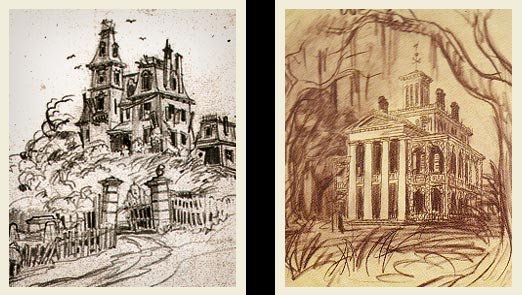
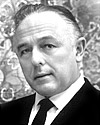 In
1953, as Disneyland was being designed, Art Director Marvin
Davis (pictured at right) had worked with Walt to come up with ideas
for his park, including a proposed mysterious "Old House on the Hill"
to be set off Main Street. Coming from a cinematic background, Marvin Davis
helped Walt cement the idea of his attractions as experiences, rather than
just rides. Disney artist Harper Goff was tapped to flesh out the look of
a haunted house set in Disneyland, after the park had opened to public acclaim
and expansion was in the cards. But what might that spook house look like?
Pictured below is WED artist Sam McKim's idea of how the Haunted House might
appear, in one of McKim's early illustrations for his proposed New Orleans
section of the park.
In
1953, as Disneyland was being designed, Art Director Marvin
Davis (pictured at right) had worked with Walt to come up with ideas
for his park, including a proposed mysterious "Old House on the Hill"
to be set off Main Street. Coming from a cinematic background, Marvin Davis
helped Walt cement the idea of his attractions as experiences, rather than
just rides. Disney artist Harper Goff was tapped to flesh out the look of
a haunted house set in Disneyland, after the park had opened to public acclaim
and expansion was in the cards. But what might that spook house look like?
Pictured below is WED artist Sam McKim's idea of how the Haunted House might
appear, in one of McKim's early illustrations for his proposed New Orleans
section of the park.
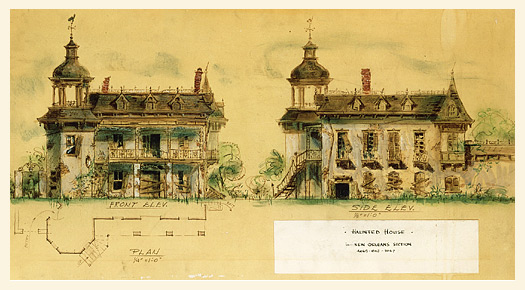
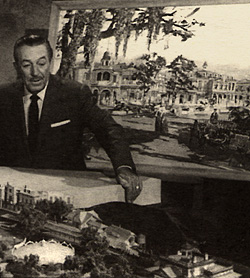
This old house
Many of Goff's early designs (such as the sketch at top left) suggest a building that might have come from the storybook rural midwest, since one idea for the haunted house was to build it on a crooked path just off of Disneyland's Main Street. However, as Disneyland evolved through the '50s, the decision was made to place the haunted house in a planned New-Orleans-themed section of the park, which was still on the drawing boards. McKim had been creating extensive architectural designs for this area of the park. Once Anderson began working on the project, the architectural design took a turn toward early 19th century southern plantation-style design, to fit the turn-of-the-century Louisiana theme planned for the area of the park. Pictured above: Walt Disney gives a presentation about the plans for New Orleans Square. Note the Haunted Mansion model in the lower corner.

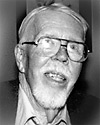 Harper
Goff (left) and Ken Anderson (below) were instrumental in
the early stages of the Mansion's planning. Goff
and Anderson
are both Disney Legends, as certified by the Walt Disney Company, for
their numerous contributions to the company's projects. Goff met Walt
Disney in 1951, and their partnership eventually led him to create the
"Nautilus" model for "20,000 Leagues Under the Sea,"
and, eventually, to create
environments for the Disney theme parks.
Harper
Goff (left) and Ken Anderson (below) were instrumental in
the early stages of the Mansion's planning. Goff
and Anderson
are both Disney Legends, as certified by the Walt Disney Company, for
their numerous contributions to the company's projects. Goff met Walt
Disney in 1951, and their partnership eventually led him to create the
"Nautilus" model for "20,000 Leagues Under the Sea,"
and, eventually, to create
environments for the Disney theme parks. 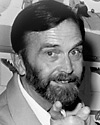 Anderson
started with the company in 1934, soon to become art director for some
seminal features as "Snow White" and "Pinocchio,"
and eventually performing architectural work for Disneyland.
Anderson
started with the company in 1934, soon to become art director for some
seminal features as "Snow White" and "Pinocchio,"
and eventually performing architectural work for Disneyland. You can learn much more about the work of Goff and other early Disneyland designers in the wonderful book "The Art of Disneyland".

A closer look
The 1957 rendering of the proposed "Haunted House" by Ken Anderson (top of page, right) was originally rejected by Walt Disney, though it eventually became the design used for the attraction. Anderson had created his sketch by placing a pre-existing Balitmore house he discovered in a catalog of Victorian works into an overgrown, imaginary New Orleans bayou - an idea Walt didn't accept in theory, as he wanted each structure in Disneyland to be kept propertly, ghost house or not. This will be discussed further when we take a closer look at the Mansion's architecture on a following page. Nevertheless, Anderson concerned himself primarily with the concept and story of the ghost house experience, rather than its appearance - and the house he discovered in Baltimore became the de facto model for the Haunted Mansion.
Stories from the bayou
Disneyland had suddenly set the bar for themed entertainment higher than it had ever been set before, and the public responded overwhelmingly. Walt's park was entertaining, educational, enthralling, and above all, experiential. In deciding to add a haunted house to the park, Walt was also distinctly throwing down the gauntlet by inviting comparison to the standard-issue creaky carnival "jump 'n boo" dark ride. Walt's team of Imagineers (or "Illusioneers," as he would frequently refer to them during the development of the Mansion) began to create the New-Orleans-themed experience that would become the Haunted Mansion.
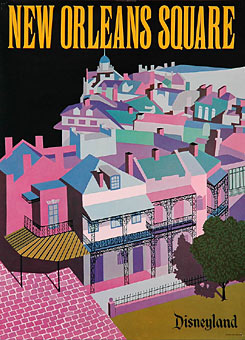 In
fact, the Haunted Mansion facade was built around the same time that the
New Orleans Square area of Disneyland (see vintage poster, right) was under
construction, which would replace Disneyland's "Holidayland" area
of the park. New Orleans Square opened in July of 1966, though the Haunted
Mansion building would sit unoccupied for another three years.
In
fact, the Haunted Mansion facade was built around the same time that the
New Orleans Square area of Disneyland (see vintage poster, right) was under
construction, which would replace Disneyland's "Holidayland" area
of the park. New Orleans Square opened in July of 1966, though the Haunted
Mansion building would sit unoccupied for another three years.
An early working title for Ken Anderson's vision of the Haunted Mansion attaction was "Bloodmere Manor," named after a fictional Captain Blood (or "Bloodmere", or "Gore", depending on who tells the tale) and his family, all of whom met their demise in the Haunted Mansion. The story revolves around a sea captain and his bride, and the few remnants of this tale (until the basic concept was recently altered by changing the bride as part of Disneyland's 50th anniversary renovations) were the weather vane in the shape of a ship, and the bride in the attic. Walt Disney World's Mansion also includes one of the early character designs of a ghostly mariner in its hall of portraits. It is not unlikely that this proposed nautical theme was intended to suggest a connection to the nearby "Pirates of the Caribbean" attraction.
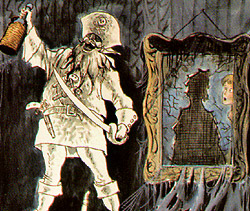

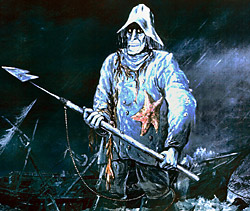
To the left (top) is one of Imagineer Marc Davis' earliest concept sketches involving a nautical theme. In this case, Davis was clearly tying the Haunted Mansion to the theme he had created for "Pirates of the Caribbean." Notice the guest observing the scene through a window - at this point in the Mansion's development, the attraction was considered to be an experience that would be walked through, as opposed to a "ride."
- Kat Cressida, "Haunted Mansion Bride"
Also pictured (bottom) is a painting of "The Sea Captain", based on an original character design by Davis. This character is likely a remnant of the nautical theme that was considered early in the attraction's history, and the painting appears in the Walt Disney World Mansion's portrait gallery. However, Davis has said that the Disney attractions are "experiences, not stories, that need no beginning and end," so the idea of leaning heavily on backstory was left behind fairly early in the conceptualization process.
In recent interviews, Imagineer Rolly Crump has made reference to the tale of the sea captain, referring to a very dark scenario in which the captain, who has drowned at sea, comes back as a ghost in a murderous rage to destroy his bride by entombing her in the brick walls of the fireplace. In fact, in early tests of proposed special effects for the attraction, Crump and Imagineer Yale Gracey developed a sample set in a Disney Studio warehouse with an intricate effect that portrayed the grizzled sea captain drenched and dripping from a storm at sea. The captain would then seemingly vanish before the viewers eyes, leaving nothing but a puddle of water on the floor behind as the skeletal ghost of his murdered bride flew menacingly out of the brick fireplace toward the audience, only to vanish into thin air as well. This scene, incorporating intricate versions of classic dark ride effects such as "Pepper's Ghost" and a pulley system similar to the "Flying Crank Ghost," demonstrated how this attraction wasn't going to be any typical "jump 'n boo" carnival fun house.
Voice talent Kat Cressida, who can be seen and heard as the "Black Widow Bride" character installed in Disneyland's Haunted Mansion's attic, has told a more romantic and detailed version of the "Captain Blood" tale. Cressida grew up hearing stories from the WED Imagineers as told by her father, who worked with the marketing and creative departments at Disneyland in the '60s and '70s. Click here to listen to Cressida tell the full story as she remembers hearing it as a child. The tale she tells, which includes piracy, intrigue, a mysterious bride and a murderous plot, demonstrates how detail-oriented and creative the original attraction designers were when creating backstories for the attractions, even when the story might only be used to inform some of the visual details of the attraction.
What's with WED?
When Walt Disney was creating Disneyland, he drew upon the best and brightest artists that Walt Disney Productions had on the roster. This part of Walt Disney Productions eventually came to be known as WED Enterprises, Inc. - named simply after Walt E. Disney's intials. By the mid '60s, when the division had moved into their own space in Glendale on Flower Street, the name WED was prominently announced to the corporate world (in the hopes that WED might be able to pick up some corporate work in-between Disneyland gigs.) Frank Allnutt, WED's public relations manager at the time, described WED this way in a corporate promotional brochure:
"When you enter the doors at WED, you step in a unique world of creativity where ideas become realities... where imagination is the basic raw material... where the impossible is accomplished everyday. Officially titled WED Enterprises, Inc.... this is the master planning, architecture, engineering, research and development subsidiary of Walt Disney Productions. Shortly after WED was organized by Walt Disney in 1952, he fashioned it into the versatile instrument he needed to plan and design Disneyland. With WED, Walt literally added a new dimension to Disney entertainment. The abilities of those who had worked by his side for years in the two-dimensional world of films were rechanneled into the design of three-dimensional attractions for the Magic Kingdom. They became project designers, sculptors, research and development technicians, model builders and interior decorators. He complemented these talents by adding highly flexible architects, engineers and draftsmen who could design yesterday, tomorrow and the timeless world of fantasy..."
WED Enterprises, Inc. would eventually go on to be renamed Walt Disney Imagineering - but the title "Imagineer" is one that Walt had given his crew of designers even prior to the official organization of WED.
Crafting a Storyline: A Look Into the Creative Process
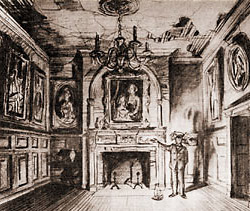
The tale of the sea-faring "Captain Blood" wasn't the only idea tossed around by the early designers of the attraction. Many of Ken Anderson's early concept sketches portrayed the attraction as a "walk-through," in which groups of visitors would be led by a mysterious guide (pictured at left). Pictured further down the page is another piece of concept art by Anderson, likely a storyboard from one of his proposals for the Mansion storyline. Interestingly, this scene shows both a ghostly sea captain and a headless apparition - both of which featured prominently in some of Anderson's early treatments for the Haunted Mansion, in which a definite tale would be told throughout the experience, from beginning to end. Click here to see a complete layout of Anderson's proposed "Ghost House" which he designed in 1957, an experience which culminated in a ghostly nuptial ball. Pictured below is a detail from the layout, featuring an encounter with a certain famous headless spectre...
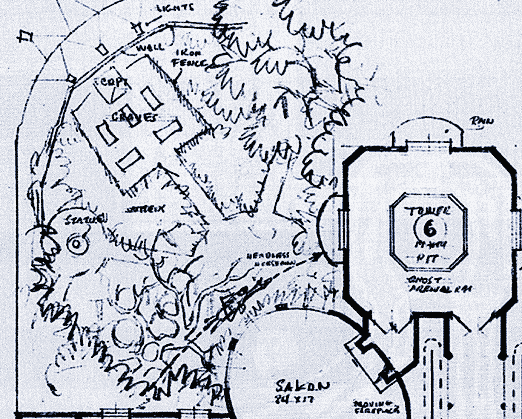
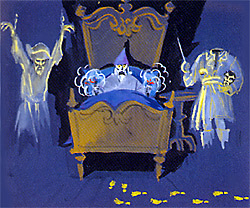
One of Walt Disney's ideas for Anderson's original walk-through spook house was to base the experience in New England (as the Haunted Mansion in Walt Disney World is currently themed), and rather than tying the theme to the "Pirates" attraction, the storyline might have featured Ichabod Crane's fateful encounter with the Headless Horseman, as featured in the 1949 Disney film The Adventures of Ichabod and Mr. Toad. DoomBuggies has obtained a file written by Ken Anderson in October of 1957, describing the effects surrounding the climax of the attraction (a close encounter with the Horseman) and how they were to be accomplished. Interestingly, many of the Haunted Mansion's special effects utilized in the graveyard remain the same as Anderson envisioned them to this very day. Click here to read Anderson's treatment for the "Ghost House" based on "Ichabod" in Anderson's own words. The file offers a fascinating glimpse of how Walt's "Illusioneers," as he sometimes called them, presented their ideas and stories for consideration.
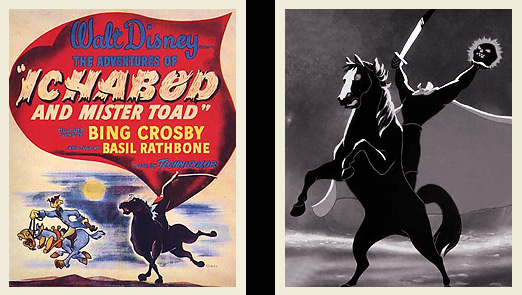

 In
addition to Anderson's proposed physical special effects, Imagineers
Yale
Gracey and Rolly
Crump were also busy devising clever illusions for the attraction.
Many of the ideas for these effects were based on 19th century techniques,
and some of the ideas came from a simple children's book entitled The
Boy Mechanic by D.R. Klien, published in 1913.
In
addition to Anderson's proposed physical special effects, Imagineers
Yale
Gracey and Rolly
Crump were also busy devising clever illusions for the attraction.
Many of the ideas for these effects were based on 19th century techniques,
and some of the ideas came from a simple children's book entitled The
Boy Mechanic by D.R. Klien, published in 1913. 
Pictured above are the 1949 "one sheet" from Walt Disney's The Adventures of Ichabod and Mr. Toad, and a movie still, which were promotional materials created to advertise the film in theaters. The eerie artwork shows why this film was one of the subjects that received serious consideration as a potential storyline for Disneyland's haunted house. In a 1949 review of the film, Time magazine stated that "the midnight chase through a clutching, echoing forest, with the gangling, lily-livered schoolmaster in full flight before the Headless Horseman, is a skillful blend of the hilarious and the horrible. It is Disney at his facile best." Undoubtedly, Anderson considered this highly effective film a strong candidate for a basis for a visceral theme to which the audience could relate.
Lonesome Ghosts take the stage
Another film Anderson considered as a tie-in with the Haunted Mansion was Walt Disney's "Lonesome Ghosts" cartoon. "Walt had an idea that there would be a wedding in the house, and the Lonesome Ghost would guide you at certain points," Anderson told The E-Ticket magazine. "At that time we also talked about Dracula and Frankenstein and other Universal Monsters - we were trying to get in everybody!" This "Lonesome Ghosts" theme begat one of the earliest storylines that converted the "walk-through" ideas of Anderson's into an actual ride. "In Walt's story, the ghosts would not permit any restoration of the house... so only a cart, made of 2x4s, was allowed by the spirits. It would have lowered through the entranceway into the basement, then moved on some sort of a track through the attraction."
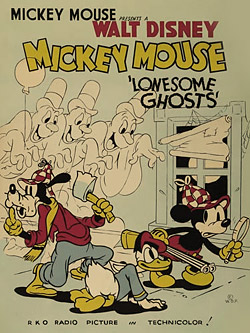 Anderson
worked on the haunted house project until 1958, at which time he went to
work on the Sleeping Beauty film. But prior to leaving, he had begun building
many of his story ideas and concepts into reality to demonstrate for Walt
Disney by filling a soundstage at the Disney studios with various scenes
and effects with the help of Disney Studio's engineer Bob Mattey. "We
built it just as if it were to be transplanted to the park," Anderson
told The E-Ticket. "There were interiors designed for Walt and
others to come and look at."
Anderson
worked on the haunted house project until 1958, at which time he went to
work on the Sleeping Beauty film. But prior to leaving, he had begun building
many of his story ideas and concepts into reality to demonstrate for Walt
Disney by filling a soundstage at the Disney studios with various scenes
and effects with the help of Disney Studio's engineer Bob Mattey. "We
built it just as if it were to be transplanted to the park," Anderson
told The E-Ticket. "There were interiors designed for Walt and
others to come and look at."

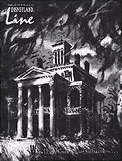 Disneyland Line
Disneyland Line
This article about the Haunted Mansion's history by Walt Disney Imagineering's late David Mumford appeared in The Disneyland Line, which is the park's internal organ. This particular issue was published in October 1993, and this article was printed in celebration of Halloween. It contains a fairly comprehensive history of the Mansion's development, and the cover art is a detail from a conceptual image by Sam McKim. Click here to read the article.




